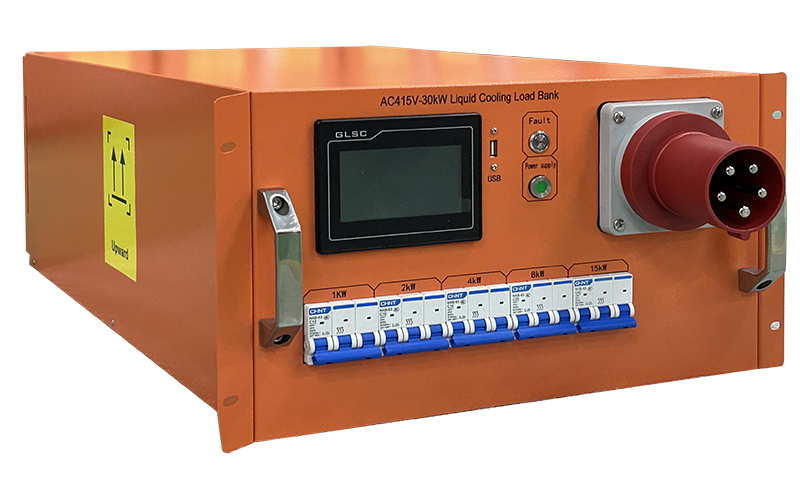Liquid Cooled Load Bank Selection Guide: 3 Core Parameters to Help You Choose the Right Equipment and Reduce Operation Costs
Time:2025-10-21
In scenarios such as high-density computing power testing in data centers and performance verification of new energy equipment, liquid cooled load banks have become key equipment in high-power testing scenarios due to their advantages of efficient heat dissipation and low energy consumption. However, many enterprises often encounter problems such as poor equipment adaptability, high operating energy consumption, and frequent failures due to improper selection, leading to a significant increase in operation and maintenance costs. In fact, selecting the right liquid cooled load bank does not require blindly pursuing high configurations. By focusing on three core parameters—load power range, heat dissipation efficiency, and temperature control accuracy—you can match actual needs, avoid operation and maintenance waste, and achieve long-term cost optimization.
Core Parameter 1: Load Power Range – Avoid "Overcapacity Waste" or "Insufficient Capacity"
The load power range is the basis for selecting a liquid cooled load bank, directly determining whether the equipment can cover actual testing needs. When selecting, you need to first clarify two key data points: the "maximum power peak" of the testing scenario and the "normal operating power range". For example, new energy charging pile testing needs to cover a wide power range of 0-200kW to adapt to performance verification of charging piles of different power models; while for small server room testing, the normal power is mostly concentrated in 50-100kW. Blindly choosing a 300kW high-power device will not only increase the purchase cost by more than 30% but also accelerate equipment aging due to long-term idleness.
It is recommended to follow the principle of "peak matching + range adaptation" during selection: the upper power limit should be 10%-15% higher than the test peak to reserve safety redundancy; the normal power range should overlap with the efficient operation section of the equipment (usually 40%-80% of the equipment's rated power). This avoids a surge in energy consumption ratio during low-load operation and reduces electricity costs from the source.
Core Parameter 2: Heat Dissipation Efficiency – Related to Equipment Stability and Maintenance Frequency
The heat dissipation efficiency of a liquid cooled load bank directly affects test continuity and failure probability. The key indicators for measuring heat dissipation efficiency are "heat dissipation power density" (power that can be dissipated per unit volume) and "coolant flow adaptability". If the heat dissipation power density is insufficient, the equipment is prone to triggering overheating protection due to heat accumulation during high-load testing, leading to test interruption; if the coolant flow does not match the equipment (e.g., the equipment requires 10-15L/min but only 5L/min is actually provided), the heat dissipation efficiency will be further reduced, increasing the risk of pump failure.
When selecting, you need to consider the coolant supply capacity of the test environment: if only low-flow coolant is available on-site, prioritize "low-flow high-heat dissipation" equipment (such as products with microchannel heat dissipation structures); if the test scenario has high power density (e.g., full cabinet testing in data centers), select equipment with a heat dissipation power density of ≥5kW/L. This reduces the equipment footprint while lowering the maintenance frequency caused by insufficient heat dissipation. Statistics show that liquid cooled load banks with suitable heat dissipation can reduce annual fault maintenance times by more than 60%.
Core Parameter 3: Temperature Control Accuracy – Ensure Accurate Test Data and Reduce Repetition Costs
In high-power testing scenarios, the temperature control accuracy of liquid cooled load banks directly affects the reliability of test data. Excessive temperature control deviation (e.g., set temperature of 35℃ with actual fluctuation of ±5℃) may lead to distorted test results and require repeated testing, which wastes time and increases energy consumption. High-quality liquid cooled load banks should have a temperature control accuracy of ±1℃ and be equipped with a "dynamic temperature control response" function—when the load power changes suddenly (e.g., from 50kW to 150kW), it can control the temperature fluctuation within the allowable range within 30 seconds to avoid test interruption.
When selecting, note that different scenarios have different requirements for temperature control accuracy: for example, power battery testing requires a temperature control accuracy of ±0.5℃, while ordinary industrial equipment testing only needs ±2℃. Accurately matching scenario requirements can avoid purchase cost waste caused by excessive pursuit of high accuracy and reduce repeated test costs due to inaccurate data. Data from a new energy enterprise shows that liquid cooled load banks with suitable temperature control accuracy can reduce the test repetition rate by 40% and save 200,000 yuan in annual labor costs.
In summary, selecting a liquid cooled load bank does not require falling into the misunderstanding of "parameter stacking". By focusing on the three core parameters of load power range, heat dissipation efficiency, and temperature control accuracy, and comprehensively judging based on actual test scenarios and long-term operation and maintenance needs, you can not only select suitable equipment but also reduce costs from multiple dimensions such as procurement, energy consumption, and maintenance, truly achieving "selecting the right equipment = saving costs".
News Recommendation
-
 2024-09-11
2024-09-11TRIUMPH LOAD EXHIBITING AT Enlit Europe 2024 -BOOTH 7.H08
-
 2023-04-21
2023-04-21TRIUMPH LOAD EXHIBITING AT DATA CENTER WORLD GERMANY 2023-BOOTH F909
-
 2023-04-06
2023-04-06TRIUMPH LOAD EXHIBITING AT ELECTRIC POWER TECH KOREA 2023 – Booth G109
-
 2022-05-05
2022-05-05What is the role of ac load bank for power supply?
-
 2022-05-05
2022-05-05What is the role of the load bank?


